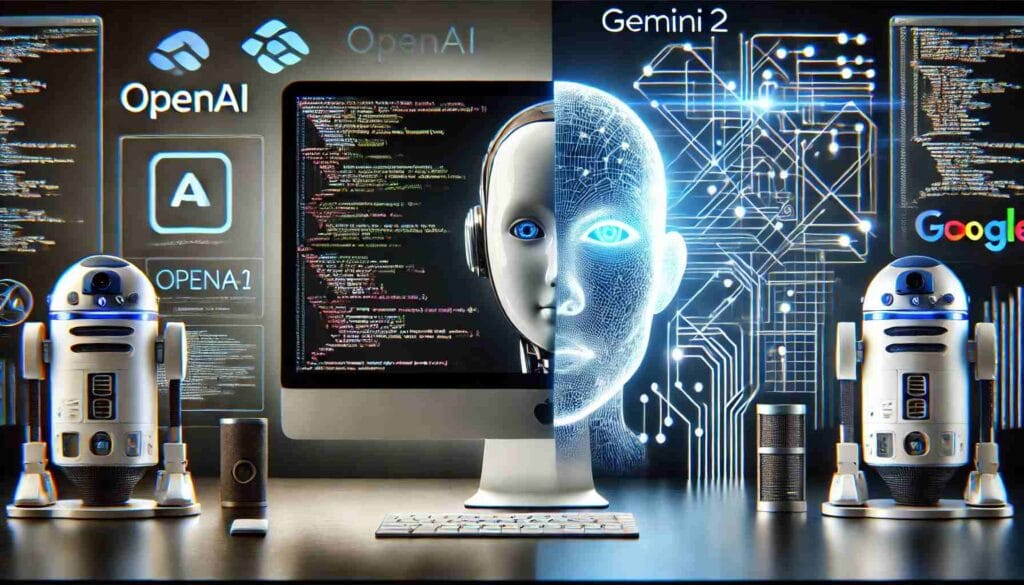Comparing OpenAI and Gemini 2: Advantages and Disadvantages

Introduction
In the rapidly evolving world of artificial intelligence (AI), two prominent players have emerged: OpenAI and Gemini 2. Both are designed to push the boundaries of machine learning and natural language processing, but each has its own strengths and limitations. This article provides a detailed comparison between OpenAI and Gemini 2, looking at the advantages and disadvantages of each.
1. Overview of OpenAI
OpenAI, founded in 2015, is a leading AI research organization that focuses on developing advanced artificial intelligence technologies. It is known for creating language models like GPT (Generative Pre-trained Transformer), which has revolutionized natural language processing (NLP). OpenAI also develops powerful tools for text generation, translation, and AI-based assistance.
Advantages of OpenAI:
- State-of-the-art language models: OpenAI’s GPT models, including GPT-4, are among the most advanced in the world, enabling users to generate highly coherent, contextually relevant, and human-like text.
- Diverse applications: OpenAI’s models are widely used for a range of applications, including content creation, customer service, programming assistance, and more.
- Wide adoption and ecosystem: OpenAI’s tools are used across a variety of industries, from technology companies to education and entertainment, making it a highly accessible tool.
- Regular updates and improvements: OpenAI continuously improves its models, incorporating feedback and data to enhance performance, safety, and usability.
Disadvantages of OpenAI:
- Cost: OpenAI’s services can be expensive, especially for users who require large-scale access to models like GPT-4. Subscription-based models may not be feasible for all users.
- Limited personalization: While OpenAI provides great general responses, it may lack the ability to deeply personalize interactions based on specific user histories or preferences.
- Dependence on large datasets: OpenAI models, like GPT, rely heavily on vast amounts of training data, which can lead to biases or inaccuracies in generated responses.
2. Overview of Gemini 2
Gemini 2 is the second generation of Google DeepMind’s AI model, designed to be a successor to the Bard AI. Gemini 2, like OpenAI’s models, is aimed at creating human-like text but with a focus on integration with Google’s vast data ecosystem and tools. Gemini 2 incorporates advancements in reasoning and processing speed, making it a powerful competitor in the AI space.
Advantages of Gemini 2:
- Integration with Google’s ecosystem: Gemini 2 is closely tied to Google’s vast knowledge base and search engine, allowing it to provide more accurate and contextually relevant information.
- Enhanced reasoning capabilities: Gemini 2 boasts advanced reasoning abilities, allowing it to understand complex queries better and provide more nuanced answers.
- Fast processing and efficiency: Gemini 2 has been optimized for speed and scalability, making it highly efficient for both consumer and enterprise-level use.
- Continual learning: Being part of Google DeepMind, Gemini 2 benefits from continuous training and integration with the latest developments in machine learning and AI.
Disadvantages of Gemini 2:
- Limited availability: Gemini 2’s access might be more restricted compared to OpenAI, and not all users have the same level of access to its capabilities.
- Bias from Google data: While Gemini 2 is highly powerful, it may be influenced by biases from Google’s datasets, affecting the objectivity of its responses.
- Privacy concerns: Being developed by Google, users may have concerns about how their data is used and the privacy implications of using Gemini 2.
- Lesser user adoption: While Gemini 2 has significant potential, it has yet to achieve the widespread adoption that OpenAI’s models enjoy.
3. Direct Comparison: OpenAI vs. Gemini 2
Capabilities:
- Both OpenAI and Gemini 2 excel at natural language processing, but Gemini 2 has the edge in reasoning and data processing speed due to its integration with Google’s ecosystem. OpenAI’s GPT models, however, are better suited for general-purpose applications and have a broader range of specialized models.
Data and Accuracy:
- OpenAI’s GPT models are highly accurate and reliable, especially in creative text generation. However, Gemini 2 leverages Google’s vast data resources, which gives it an edge when it comes to retrieving factual information quickly and efficiently.
Personalization and Customization:
- OpenAI’s GPT models offer some customization options, but Gemini 2 has better integration within Google’s broader product suite, potentially providing more tailored responses based on a user’s search and interaction history.
Cost and Accessibility:
- OpenAI’s subscription model can be a barrier for some users, especially when access to powerful models is required. Gemini 2, on the other hand, may be more accessible for those already integrated into the Google ecosystem, but its availability may be limited depending on region or specific use cases.
4. Conclusion
Both OpenAI and Gemini 2 have their own strengths, and the choice between the two largely depends on the specific use case and requirements of the user. OpenAI is well-suited for general-purpose AI applications with a focus on language generation, while Gemini 2 excels in reasoning, efficiency, and integration with Google’s vast data ecosystem. By understanding their advantages and limitations, users can make informed decisions on which platform best serves their needs.
Source : Medium.com




